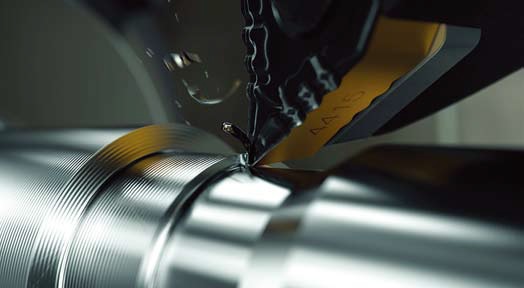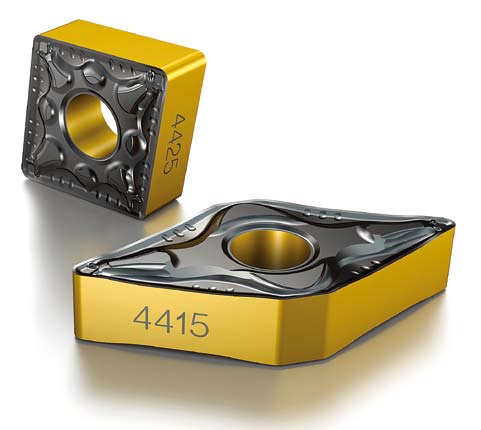
A recent survey by OpenText found that 92% of manufacturers consider corporate social responsibility (CSR) to be important for their overall reputation in the markets. Even though steel turning is, by nature, a waste producing process, it is possible for manufacturers to improve their sustainability without compromising process security — even against the unprecedented challenges of COVID-19. Here Rolf Olofsson, Product Manager at Sandvik Coromant, the global leader in metal cutting explains a different approach to steel turning.
According to the 17 Global Goals for Sustainable Development set out by the United Nations (UN), manufacturers are expected to minimise their environmental impact while going further than just optimising energy use. Although CSR is important to companies, Sandvik Coromant estimates that manufacturers waste between 10% to 30% of material in their machining processes, with a typical machining efficiency of below 50%, which includes at the design, planning and cutting phases.
So, what can manufacturers do? The UN’s goals recommend two main avenues that consider such factors as a growing population, finite resources, and the linear economy. The first is to address these challenges with technology. Industry 4.0 concepts — like cyber physical systems, big data, or the Internet of Things (IoT) — are frequently cited as being the way forward for manufacturers seeking to reduce waste.
Yet, this does not allow for the fact that most manufacturers are yet to apply modern machines with digital capabilities to their steel turning operations.
Most manufacturers are aware of how important the choice of insert grade is for making steel turning more efficient and productive; and how this affects overall performance and tool life. However, many are missing a trick by not considering the whole tooling concept; everything from advanced inserts, tool-holders and easy-to-adopt digital solutions. Each of these factors can help to make steel turning more sustainable by reducing energy consumption and minimising waste.
Reduced cutting speeds
Manufacturers face several challenges in their steel turning operations. These include getting more pieces per edge from a single insert; increasing metal removal rates; reducing cycle times; optimising inventory levels; and, of course, minimising material waste.
But what if there was a way to achieve all these challenges, but geared overall towards greater sustainability? One way to reduce energy consumption is to reduce cutting speeds. Manufacturers can maintain productivity by proportionally increasing the feed rate and depth of cut. In addition to saving energy, this also results in longer tool life. In steel turning processes, Sandvik Coromant has found that an average tool life increase of 25%, in combination with reliable and predictable performance, can minimise material waste both from the workpiece and the insert.
The right choice of insert grade goes some way towards achieving this. That’s why Sandvik Coromant is adding a pair of new P-turning carbide grades, designated GC4415 and GC4425, to its range. GC4425 delivers improved wear resistance, heat resistance and toughness, while grade GC4415 is designed to complement GC4425 when enhanced performance and more heat resistance is needed.
Importantly, both grades can be used with tough materials like Inconel and unalloyed stainless-steel ISO-P grades that are especially complex and tough to machine. The right grade can help machine a larger number of pieces within mass and/or batch production processes.
The GC4425 grade provides extremely high process security through its ability to retain an intact edge line. Because the insert can deliver more pieces per edge, fewer carbide is consumed to machine the same number of components. Furthermore, inserts with consistent and predictable performance avoid workpiece damage, which minimises workpiece material waste. Both advantages reduce the amount of scrap produced.
Furthermore, with both GC4425 and GC4415, the insert’s substrate and coating have been developed to better withstand high temperatures. This reduces the effect that causes excessive wear and, as a result, the material is highly capable of maintaining the insert edge line at higher temperatures.
However, manufacturers should also consider using coolant with the insert. If using a tool that features over- and under- coolant, turning off the over-coolant can be beneficial in certain operations. The primary functions of cutting fluid are chip evacuation, cooling, and lubrication between the tool and the workpiece material.
If applied correctly, it will maximise the output, increase process security, and improve the tool performance and component quality. Using tool holders with internal coolant provision can also improve the insert tool life.
Peel back the layers
GC4425 and GC4415 each contains the second-generation Inveio® layer, a textured chemical vapor deposition (CVD) alumina (Al2O3) coating developed for machining. Examining Inveio at the microscopic level reveals that the material’s surface is characterised by a uni-directional crystal orientation. Furthermore, the crystal orientation has been improved significantly within the second-generation Inveio coating. Even more so than before, each crystal in the alumina coating is lined-up in the same direction, which creates a strong barrier towards the cutting zone.
Inveio provides the insert with high wear resistance and longer tool life. Longer lasting tools are, of course, favourable to reducing cost-per-part. Moreover, the material’s carbide substrate contains a high proportion of recycled carbide material, making them one of the most environment-friendly grades.
To put these claims to the test, the GC4425 grade has been subjected by Sandvik Coromant’s customers to pre-market tests. Among these was a general engineering company that applied both a competitor’s insert, and the GC4425 insert, in the manufacture of pressure rollers. An ISO-P grade was subjected to continual external axial machining and semi-finishing at a cutting speed (vc) of 200m/min, feed rate of 0.4mm/rev (fn) and depth (ap) of 4mm.
Manufacturers typically measure tool life by the number of workpieces machined (pcs). Whereas the competitor’s grade machined 12 pieces before wearing out due to plastic deformation, Sandvik Coromant’s insert produced 18 pieces and, in doing so, worked 50 per cent longer with stable and predictable wear.
The example shows the gains that can be achieved if the right machining elements are brought together, and how recommendations on first-choice tools and cutting data, from a trusted partner like Sandvik Coromant, can help achieve process security and reduce time wasted in finding the right tools. Online tools have also proven popular in helping manufacturers assess the best turning inserts and grades for their requirements, such as the CoroPlus® Tool Guide.
To help with process monitoring itself, Sandvik Coromant has also developed CoroPlus® Process Control software that can monitor machining in real-time and act according to programmed protocols if specific issues occur — for example, by stopping the machine or replacing a worn cutting tool.
A perfect circle
This brings us to the UN’s second recommendation for more sustainable tooling: moving to a circular economy, whereby waste products are seen as raw material and put back into a resource-neutral cycle. It is increasingly clear that a circular economy can be both environmentally sound and profitable for manufacturers.
This includes recycling solid carbide tools — after all, we all come out as winners when worn-out tools are kept out of landfills and junkyards. GC4415 and GC4425 each contain a significant amount of recycled carbide. Making new tools from recycled solid carbide requires 70% less energy than making them from virgin raw materials, and it also means that 40% less carbon dioxide is emitted.
Then there is the carbide recycling program by Sandvik Coromant, available to all our customers worldwide. The company buys-back worn inserts and round tools, regardless of origin, from its customers. This is necessary if you consider how scarce and finite raw materials will be, in the long run. Estimated reserves of tungsten, for example, are around 7 million tonnes, which leaves us with about 100 years of consumption. The recycling initiative has brought Sandvik Coromant to an 80% circularity through the carbide buy-back program.















